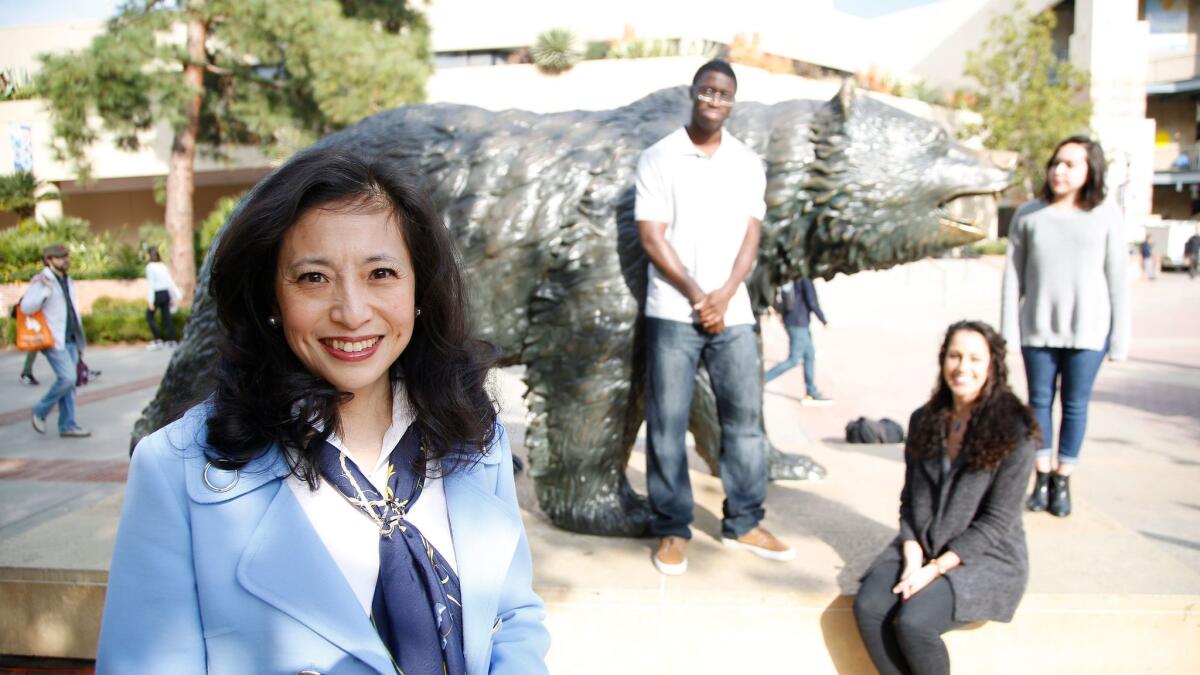If Brown phases out college scholarships for middle-class students, stressed parents wonder: ‘How are we going to make this work?’

Jill Cohen-Sandler tosses and turns at night, her mind filled with anxiety over how she and her husband will pay for their daughter to attend the University of California.
She’s a state rehabilitation counselor. He’s a retired teacher. Together, the Santa Rosa couple brings in $103,000 annually. That’s too much to qualify for the major financial aid programs but not enough to pay the $34,000 total annual cost of a UC education. The financial pressures may force their daughter Rose to attend community college, despite her 4.66 GPA as a senior at Maria Carrillo High School, her mother said.
“I wake up in the middle of the night thinking about this stuff,” Cohen-Sandler said. “I’m constantly calculating, how are we going to make this work?”
Many middle-class families across California face similar struggles. And those problems are likely to deepen soon if UC and Cal State leaders approve the first tuition increases in six years and Gov. Jerry Brown makes good on his budget proposal to phase out the state’s only scholarship program for middle-class students.
Cohen-Sandler said she had counted on a middle-class scholarship for Rose’s education. But even with that $3,000 scholarship, $4,000 from their college savings plan, $5,500 in loans and the $5,000 they believe they can spare from their paychecks, she said, the family still would be short nearly half the money needed for a year at UC.
Families used to be able to afford college. But the cost of attendance for middle-class families has become unbearable.
— Lupita Cortez Alcalá, executive director of the California Student Aid Commission
She has written to Brown and other state politicians, pleading to spare the Middle Class Scholarship program, which was designed to cover up to 40% of tuition and fees for UC and Cal State students whose annual family income and household assets (excluding primary homes and retirement accounts) each fall below $156,000. The far larger Cal Grant program covers needier students — the income ceiling for a family of four this year, for instance, was $90,500.
The middle-class program has offered nearly 190,000 scholarships in the last three years, according to the California Student Aid Commission. About 40% go to low-income students who don’t make the cut for the Cal Grant program. Four-fifths of recipients are Cal State students, who received a maximum award of $1,641 this year. UC students’ maximum scholarship was $3,688, the commission said.
Brown’s proposal would retain current students’ awards but begin phasing the program out for new students in the 2017-18 school year. He says it’s necessary given lagging state revenue, a state deficit that — without action — could hit $1.6 billion by summer and the need to retain aid for the state’s neediest students.
As H.D. Palmer, the state finance department spokesman, said in a statement, “We believe that gradually phasing out the Middle Class Scholarship Program will allow us to continue to maintain the Cal Grant entitlement program that’s focused on those students with the greatest financial need.”
Rafi Sands, a UCLA student body leader campaigning for more middle-class support, criticized that rationale.
“It’s pitting groups of students against each other,” said the junior, who studies business, economics and political science. “There’s an idea that middle-class students don’t deserve to be asking for aid and don’t need it, but from what I’ve seen, people could not be more wrong about that.”
Sands and other UCLA students are rallying to share stories of the middle-class struggle, save the scholarship program and press UC leaders for more support.
A 2016 UC report on financial aid found that, between the 2008-09 and 2011-12 academic years, annual levels of student borrowing and cumulative debt at graduation increased the fastest among middle-income students — and rates of borrowing have not declined as quickly for them as for other income groups.
The report also found that the proportion of students whose families earned between $107,000 and $134,000 declined from 11% of undergraduates in 2007-08 to 7% in 2014-15. Over the same period, those students whose families earned less than $27,000 annually grew from 13% to 19%.
The recession prompted major funding cuts. Tuition and fees more than doubled to the highest levels in state history: $5,472 for CSU and $12,294 for UC, while student costs for housing, food and books also grew.
The scholarship program was aimed at helping middle-class families manage those hikes, said Lupita Cortez Alcalá, executive director of the California Student Aid Commission. The award amounts, she said, are relatively small but richly deserved by those who have worked hard, saved, taken out loans and “done everything right”— yet still struggle to pay for college.
“Families used to be able to afford college,” she said. “But the cost of attendance for middle-class families has become unbearable.”
David Lopez, president of the California State Student Assn., said the middle-class scholarship bailed him out during his second year at Cal State East Bay. He used it for costly textbooks, allowing him to work just 20 to 30 hours a week and focus more on school.
“For our middle-class students, any little bit helps.” Lopez said. “Not having this will be detrimental to our students, and may cause a delay in graduation.”
Some UC campuses try to help such families on their own. UC Davis offers a $3,000 “Aggie Grant,” and UC Berkeley caps parent contributions at 15% of total income for families earning $80,000 to $150,000.
UCLA is aiming to raise $1 billion for scholarships as part of its $4.2-billion Centennial Campaign. UCLA Foundation President Shirley Wang said middle-class students would be a priority; she and her husband donated $1 million for scholarships.
“We have to make sure that people who work hard can send their children to college,” Wang said. “We need to fill that gap.”
Chancellor Gene Block, who has launched a 50% match program for certain scholarship donations, said such student aid was crucial for attracting top students.
Cal State officials say they do not have similar resources to make up the gap if the middle-class program is cut. Dean Kulju, Cal State’s director of student financial aid services and programs, said there are few other financial aid options besides federal loans for middle-class students.
But he said far more CSU students receive Cal Grants than middle-class scholarships: About 121,000 to 38,000, respectively, last year. The Cal Grant aid has more than doubled in five years to $635 million in 2015.
Choosing how to prioritize is not easy, especially with so many students in need, said Kulju, adding that lawmakers could consider broadening the income range for Cal Grants.
Assemblyman Kevin McCarty (D-Sacramento) said he plans to consider such ideas at a hearing next month on how to expand financial aid.
In Santa Rosa, meanwhile, Rose Cohen-Sandler is hedging her bets by also applying to private universities with more generous financial aid packages. One already has offered a $25,000 scholarship.
But the UC still has her heart.
“It’s really disappointing to want to stay in the state but almost feel you have to go out of state to escape large debts,” she said.
Twitter: @teresawatanabe
Twitter: @RosannaXia
ALSO
California’s budget deficit is back, Gov. Jerry Brown says
State fails to inspect scores of hospitals with high infection rates
Feds sue nation’s largest student loan servicer, accusing it of cheating borrowers



